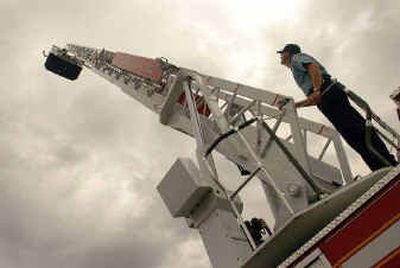Kootenai Fire and Rescue gets new vehicle

POST FALLS — The ladder on Kootenai County Fire and Rescue’s new aerial platform ladder truck extends 100 feet, but it’s unlikely to see much use fighting fires in high-rises.
Rather, it’s fires in low, warehouse-type buildings with broad expanses of roof – the kind that are popping up as more businesses continue to locate to the Post Falls area – that the 48-foot, 76,800-pound ladder truck is ideal for taking on.
Lt. John Ward says the ladder can be extended horizontally out over the roofs of such commercial and industrial buildings, enabling firefighters to safely get at the flames.
The truck, housed in Post Falls and put into service Sept. 1 after truck selection committee members drove it from Pierce Manufacturing, in Appleton, Wis., is also ideal for fighting fires at apartment buildings that have carports in front. Fire rescue is safer for both firefighters and citizens because the steel, 17,300-pound ladder can extend horizontally 90 feet, allowing firefighters to bypass carports and other dangerous barriers, Ward says.
Some features of the new ladder truck include a 490-horsepower Detroit Diesel engine, 154 feet of ground ladders, and a maximum water flow of 2,000 gallons per minute without a hydrant connection. The outstanding feature is the 100-foot ladder and aerial platform, which is capable of carrying 1,000 pounds of load without water, and 500 pounds with water. The ladder also rotates 360 degrees in the extended position.
“This truck is new to us and more technologically advanced than past trucks, so the whole department will undergo intense training,” Ward says.
The platform also allows citizens to be safely transported to the ground from a multifloored structure, whereas conventional “straight sticks,” a term used to describe nonaerial platform ladder trucks, require citizens to climb down ladders. When a person is scared and inexperienced, climbing down a high ladder can be daunting, Ward says.
The new ladder truck, which replaced a 1981 engine, cost $733,381, an amount figured into the 2003-04 budget. Although Kootenai County Fire and Rescue applied for grants, none was obtained.
The committee chose the truck after what Ward terms “a long and intensive” process, with members spending eight months of the more than yearlong process determining what ladder truck specifications would best serve the public. The committee continues to meet to outline the best and most effective ways to use the new ladder truck and to develop training instruction.
Ward says the truck is a valuable, usable piece of equipment with no “frills,” and the committee bypassed certain options in order to reduce costs. Trucks are generally in service for about 20 years before a replacement is contemplated. Once a truck has been replaced, it serves as a reserve engine.
“The most important aspect of this (new ladder truck) is that the new equipment will help us better serve and protect the public,” says Ward.